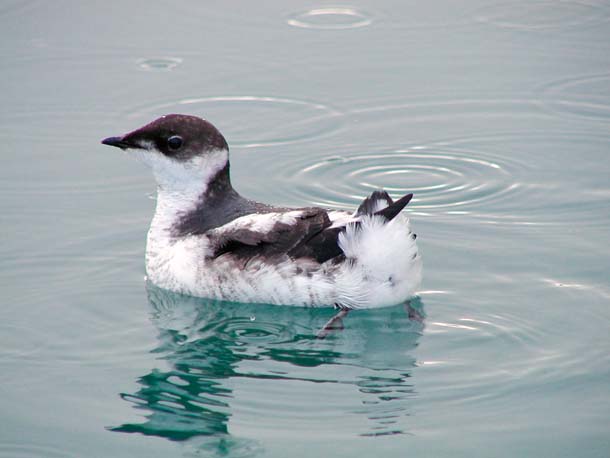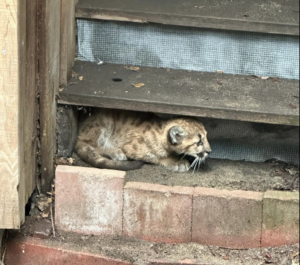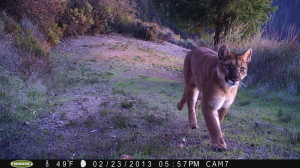This is a story about a little-known bird that’s no owl, eagle, or peacock. It’s not featured on a stamp or in a Disney cartoon. Most people haven’t heard of it and can’t even pronounce its name. But dig deeper into the “marbled murrelet” (that’s MER-let, not mure-a-LET), and you’ll find a story of scientific mystery and dedicated people working to help an increasingly scarce bird and its habitat.
Part of the auk family, which includes puffins, razorbills, and auklets, murrelets dive underwater in the ocean to feed on anchovies and sardines. What makes these birds special, however, is that while all other auks nest on seaside cliffs and bluffs, the murrelet nests inland in old-growth redwoods and Douglas firs.
So I meet environmental consultant Steve Singer far out of sight of the ocean, at the Gazos Mountain Camp in Butano State Park in the Santa Cruz Mountains. A white-bearded former ranger, Singer points up to the thousand-year-old trees and explains that murrelets look for wide, flat-topped, mossy branches with grooves to cradle their pale-green, brown-spotted eggs. The nests seem hard to reach even for the birds: “This bird is not adept at landing because of its webbed feet,” says Singer. “Sometimes they miss the landing strip completely, circle back and try again.”
Ornithologists once considered the whereabouts of those nests “one of the last great ornithological mysteries in North America.” Then, in 1974, a pruner named Hoyt Foster was working at nearby Big Basin Redwoods State Park. At 150 feet up in an old Douglas fir, he came across an odd-looking, football-shaped bird. He called a ranger, who wrapped the bird in a T-shirt and set it in a cardboard box. Other rangers, including Steve Singer, stopped by to take a peek. They realized that Foster had become the first person to discover a murrelet nest.
Seeing a murrelet nest is almost impossible, and spotting adults out of the nest isn’t much easier. The males and females share nesting and chick-rearing, and each dawn and dusk, one of them leaves to hunt at sea, while the other stays to incubate their single egg. To see the changing of the guard, you must rise before dawn and sit in the cold for hours, only to glimpse a blurry spot streak by at breakneck speed–murrelets often fly at 50 miles an hour and have been clocked at 103.
Singer spends a lot of early mornings here as part of a research effort begun in 1998. In the late 90s, the Sempervirens Fund, a land trust focused on the Santa Cruz Mountains’ redwood forests, received $500,000 in oil-spill mitigation funds to protect murrelet breeding habitat. Those funds helped purchase Gazos Mountain Camp, which was added to Butano in 2000.
- Marbled murrelets fly daily from their nests in old-growth forests to the ocean to forage for small fish like anchovies and sardines. Photo courtesy U.S. Fish & Wildlife Service.
Researchers conduct visual surveys on the ground and at sea and use radar to detect birds as well. Six times every July, Singer hits the forest shortly before dawn and counts murrelets for two hours. He has detected murrelets on both public and private lands.
“Data like this is key to identifying new areas for land purchases,” says Laura McLendon, Sempervirens’ field representative. Researchers map bird sightings, flyways, and old-growth groves, and have identified 30 important properties for protection. “Our acquisition priorities are rooted in science,” she says, “and we have the data to back it up.”

- (click image for larger version) Steve Singer has mapped several murrelet flyways, though he’s careful to note that not all murrelets use these particular flyways, and some may nest far from the flyways he’s found. Map from Sempervirens Fund, 2010. Sources: USGS, ESRI, CPAD, Steve Singer.
California’s murrelet population is federally listed as threatened, and the population trend seems to be downward. Female murrelets lay only one egg per season, and most nesting efforts end in failure. A major cause is increased numbers of crows, ravens, and jays, which move in along roads and other breaks in the forest, feeding on both garbage and murrelet eggs and chicks. Singer adds that the Santa Cruz Mountain murrelets are genetically distinct from populations in Alaska and the Pacific Northwest, and he estimates there are only about 500 left.
That makes the purchase and protection of contiguous areas of old-growth and surrounding forests all the more critical. Reed Holderman, Sempervirens’ executive director, says the group is committed to preserving marbled murrelets and their nesting habitat in the Santa Cruz Mountains. The group has acquired several parcels in the Gazos and Butano Creek watersheds used by murrelets for nesting. “We will buy even more land as private donations become available,” says Holderman. The goal is to create a broad swath of preserved redwood properties here. With that, even if we never get to see this rare bird, we’ll have helped it hang on to its precarious perch in the old growth.
Find out more at sempervirens.org. Thanks to Laura McLendon at Sempervirens.

.jpg)




